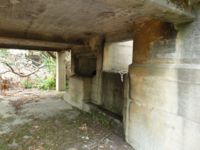Battery Graham
|
Battery Graham (1897-1918) - Battery Graham was a reinforced concrete, Endicott Period 10‑inch coastal gun battery on Fort Totten (3), New York. The battery was named in G.O. 78, 25 May 1903, after Ltc. William M. Graham, 11th U.S. Infantry, who served with distinction in the Seminole Wars, and who was killed 8 Sep 1847, at the battle of Molono del Rey, Mexico, during the Mexican-American War. Battery construction started 1896, was completed 27 Dec 1897 and transferred to the Coast Artillery for use 27 Dec 1897 at a cost of $ 218,036.94. Deactivated in 1918.
Endicott PeriodPart of the Harbor Defense of Eastern New York.  Originally built as an Endicott Period concrete coastal gun battery with two 10" M1888 guns mounted on M1894 disappearing carriages. Battery Graham, Battery Mahan and Battery Sumner formed a single battery as far as construction was concerned and they formed the main gun line at Fort Totten (3). Battery Sumner's two 8" gun emplacements were place at either end of the main gun line. All six of the gun emplacements of the main gun line were originally known as Battery Mahan, and so named in 1900. In 1903 the main gun line was administratively divided into the three named batteries. Battery Graham was a two story battery with the guns on the upper level and the magazines on the lower level. Two back delivery Hodges shell hoists were originally provided to move the shells from the magazine level to the gun loading platform. The original hoists were changed out for Taylor-Raymond shell hoists. No powder hoists were provided.

World War IThe U.S. entry into World War I resulted in a widespread removal of large caliber coastal defense gun tubes for service in Europe. Many of the gun and mortar tubes removed were sent to arsenals for modification and mounting on mobile carriages, both wheeled and railroad. Most of the removed gun tubes never made it to Europe and were either remounted or remained at the arsenals until needed elsewhere. Both of Battery Graham's guns were transferred to Fort Hamilton (1) on 25 Mar 1919. Both carriages were ordered scrapped on 26 May 1920 as a part of the 1920 disarmament program. Current StatusNo period guns or mounts in place.
Sources: Links: Visited: 21 Aug 2010
| ||||||||||||||||||||||||||||||||||||||||||||

